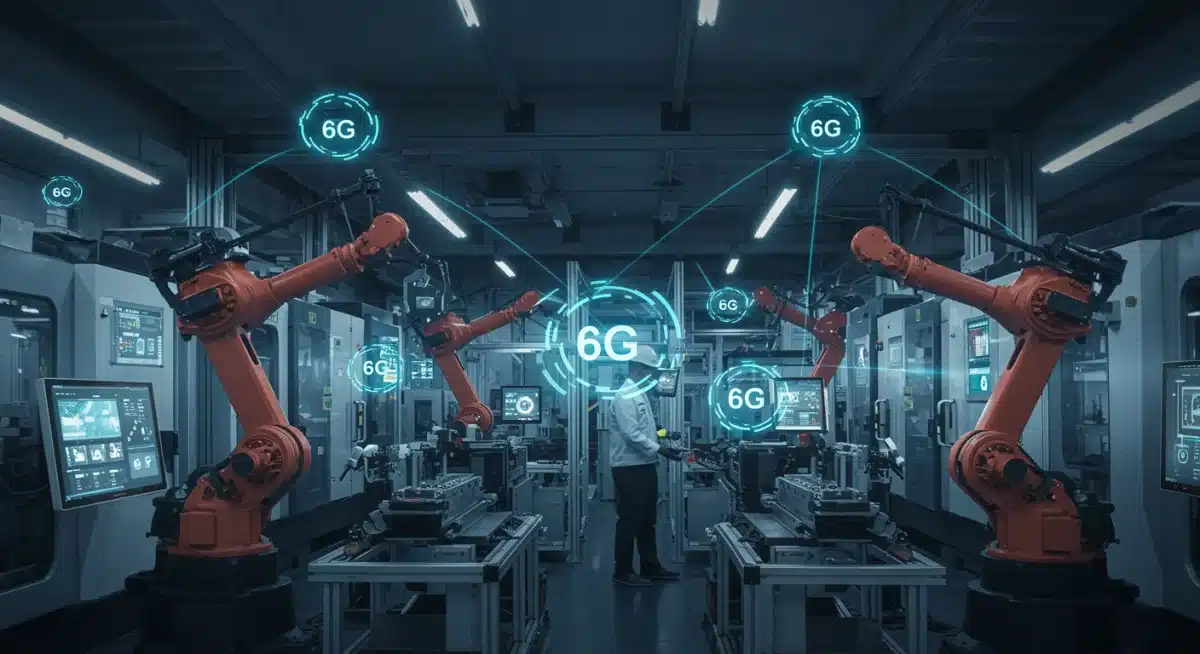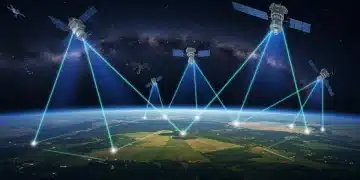How Will 6G Transform US Industries by 2030? A Practical Guide

The advent of 6G technology is poised to revolutionize various US industries by 2030, promising unprecedented speeds, ultra-low latency, and advanced connectivity that will reshape operational frameworks and foster innovation across sectors.
As the technological landscape rapidly evolves, a critical question emerges for stakeholders across the nation: How Will 6G Transform US Industries by 2030? A Practical Guide to understanding this next-generation wireless technology is essential. The imminent arrival of 6G promises to redefine connectivity, pushing boundaries far beyond what 5G currently offers. This development is not merely an upgrade; it represents a fundamental shift in how industries will operate, innovate, and compete in the coming decade.
The Dawn of 6G: What to Expect
The sixth generation of wireless technology, or 6G, is currently under intense research and development globally, with significant advancements expected to materialize by 2030. This new era of connectivity aims to deliver speeds up to 1 terabit per second (Tbps), far surpassing 5G’s capabilities, and achieve near-zero latency. These performance leaps will enable entirely new applications and services that are currently unimaginable or impractical.
Beyond raw speed and latency, 6G is anticipated to integrate seamlessly with artificial intelligence (AI), machine learning (ML), and extended reality (XR) technologies. It will foster a truly pervasive and intelligent network, where devices not only connect but also actively learn, predict, and adapt to user needs and environmental conditions. This holistic approach to connectivity will lay the groundwork for unprecedented levels of automation and intelligence across various domains.
Key Technical Advancements
Several technical innovations underpin the promise of 6G. These include the utilization of higher frequency bands, such as terahertz (THz) spectrum, which offers vast bandwidth for data transmission. Additionally, advanced antenna technologies, AI-driven network management, and integrated sensing capabilities are central to 6G’s design.
- Terahertz Frequencies: Unlocking massive bandwidth for ultra-fast data rates.
- AI-Native Network: Integrating AI directly into the network architecture for optimized performance and automation.
- Sensing and Communication: Enabling devices to not only communicate but also sense their environment, creating a digital twin of the physical world.
- Distributed Ledger Technologies: Enhancing security and trust through blockchain integration for network management and data integrity.
Manufacturing and Industrial Automation
The manufacturing sector in the US stands to be profoundly transformed by 6G. The ability to achieve ultra-reliable low-latency communication (URLLC) at scale will enable truly autonomous factories and advanced industrial automation. This means machines communicating in real-time, making instantaneous decisions, and operating with unprecedented precision.
Smart factories will leverage 6G to deploy a dense network of sensors, robots, and AI systems, all interconnected and working in harmony. This will lead to significant improvements in efficiency, productivity, and flexibility. Predictive maintenance, for example, will become highly sophisticated, with machines detecting potential failures before they occur, minimizing downtime and optimizing operational costs.
The Rise of Autonomous Systems
Autonomous mobile robots (AMRs) and automated guided vehicles (AGVs) will become standard in manufacturing, logistics, and warehousing. 6G’s robust connectivity will eliminate communication bottlenecks, allowing these systems to navigate complex environments, collaborate with human workers, and perform tasks with higher accuracy and safety. This shift will redefine supply chains, making them more resilient and responsive to market demands.
- Real-time Data Processing: Instantaneous analysis of vast datasets from sensors and machinery.
- Cobot Integration: Seamless collaboration between humans and robots on the factory floor.
- Digital Twins: Creation of virtual replicas of physical assets, enabling simulation and optimization.
- Edge Computing Synergy: Processing data closer to the source, reducing latency and enhancing decision-making.
Healthcare and Remote Care Innovations
In healthcare, 6G promises a revolution in remote care, telemedicine, and precision medicine. The ultra-low latency and high bandwidth will enable real-time transmission of high-definition medical imaging and data, facilitating remote diagnostics and surgical procedures with unprecedented accuracy. This will be particularly impactful in rural or underserved areas, bridging gaps in healthcare access.
Wearable health devices will become more sophisticated, offering continuous monitoring and predictive health analytics. These devices, powered by 6G, will transmit vital signs and other health metrics securely and efficiently to healthcare providers, allowing for proactive interventions and personalized treatment plans. The integration of AI with 6G networks will also support advanced medical research and drug discovery by processing enormous datasets more effectively.

Enhanced Telemedicine and Diagnostics
The capabilities of telemedicine will expand exponentially. Doctors will be able to conduct virtual consultations with the realism of in-person visits, utilizing augmented reality (AR) and virtual reality (VR) to enhance diagnostic accuracy. Remote-controlled robotic surgery, guided by expert surgeons miles away, will become a reality, offering specialized care to a broader patient base.
Moreover, emergency medical services will benefit from 6G by enabling paramedics to transmit live, high-fidelity patient data to hospitals while en route, allowing for immediate preparation and potentially life-saving interventions upon arrival. The network’s resilience will ensure critical communications remain uninterrupted.
Smart Cities and Urban Development
For smart cities, 6G will serve as the foundational infrastructure for truly intelligent urban environments. Everything from traffic management and public safety to waste collection and energy grids will be optimized through interconnected devices and AI-driven analytics. The vision of a fully responsive city, adapting in real-time to the needs of its inhabitants, moves closer to reality.
Traffic flow will be intelligently managed through vehicle-to-everything (V2X) communication, reducing congestion and accidents. Smart streetlights will adjust illumination based on pedestrian and vehicle presence, conserving energy. Public safety will be enhanced through pervasive sensor networks that can detect anomalies and alert authorities instantly. These systems will not only improve efficiency but also enhance the quality of urban life.
Sustainable Urban Living
6G will also play a crucial role in promoting sustainable urban living. Smart grids will integrate renewable energy sources more effectively, balancing supply and demand with greater precision. Waste management systems will become more efficient, optimizing collection routes based on real-time data from smart bins. Environmental monitoring will provide granular data on air and water quality, enabling proactive measures against pollution.
- Intelligent Traffic Management: Real-time optimization of traffic signals and routes.
- Enhanced Public Safety: Faster response times through interconnected surveillance and alert systems.
- Optimized Resource Management: Efficient use of energy, water, and waste services.
- Citizen Engagement: New platforms for citizens to interact with city services and infrastructure.
Agriculture and Food Production
Precision agriculture will experience a significant boost with 6G technology. Farmers will utilize advanced drones, autonomous tractors, and sensor networks to monitor crop health, soil conditions, and livestock in unprecedented detail. This data will enable hyper-localized interventions, optimizing irrigation, fertilization, and pest control, leading to higher yields and reduced resource consumption.
The ability to collect and analyze vast amounts of environmental data in real-time will revolutionize farming practices. For instance, sensors can detect early signs of disease in plants or animals, allowing for immediate action to prevent widespread outbreaks. This proactive approach will enhance food security and sustainability, making agricultural processes more resilient to climate change and other challenges.
Supply Chain Optimization
Beyond the farm, 6G will optimize the entire agricultural supply chain. Real-time tracking of produce from farm to fork will ensure freshness, reduce waste, and enhance transparency for consumers. Smart logistics, powered by 6G, will enable efficient transportation and storage, minimizing spoilage and ensuring rapid delivery to markets.
Furthermore, blockchain integration with 6G networks can provide immutable records of food origins and handling, boosting consumer trust and simplifying recall processes in case of contamination. This end-to-end connectivity will create a more robust and trustworthy food system.
Entertainment and Immersive Experiences
The entertainment industry is set for a dramatic transformation with 6G, particularly in the realm of immersive experiences. Ultra-high bandwidth and extremely low latency will make truly seamless virtual reality (VR), augmented reality (AR), and mixed reality (MR) applications a reality. This will enable hyper-realistic gaming, live events, and interactive content that blurs the lines between the digital and physical worlds.
Imagine attending a concert virtually with the sensation of being physically present, or participating in a collaborative design meeting with colleagues as realistic holograms. These experiences will be facilitated by 6G’s ability to transmit massive amounts of data with virtually no delay, overcoming the current limitations of existing networks. The future of entertainment will be deeply personal and highly interactive.
Holographic Communication and Digital Twins
Holographic communication, where individuals can appear as three-dimensional projections in different locations, will become feasible. This will revolutionize remote work, education, and social interactions, making virtual presence feel much more authentic. Digital twins, already gaining traction in industrial settings, will extend to personal and social contexts, creating new ways for people to interact with digital representations of themselves and their environments.
- Hyper-Realistic XR: Unprecedented realism in virtual, augmented, and mixed reality experiences.
- Cloud-Native Gaming: Gaming experiences rendered entirely in the cloud, accessible on any device without local processing power.
- Interactive Live Events: Immersive virtual participation in sports, concerts, and cultural events.
- Personalized Content Delivery: AI-driven content tailored to individual preferences and real-time contexts.
Challenges and the Path Forward
While the prospects of 6G are exciting, significant challenges remain on the path to its widespread deployment by 2030. These include the massive investment required for infrastructure development, particularly in deploying new base stations and fiber optic backbones capable of handling THz frequencies. Spectrum allocation and regulatory frameworks also need to evolve to accommodate the unique characteristics of 6G.
Security and privacy concerns will intensify with the pervasive connectivity and data collection capabilities of 6G networks. Robust encryption, AI-driven threat detection, and new authentication protocols will be crucial. Furthermore, ensuring equitable access to 6G technology across all communities in the US will be vital to prevent a digital divide, necessitating government policies and public-private partnerships.
Overcoming Deployment Hurdles

Addressing these challenges requires a concerted effort from governments, industry players, and academic institutions. Research and development into energy-efficient 6G technologies will be essential to manage the increased power demands. International collaboration will also be key to establishing global standards and ensuring interoperability, paving the way for a truly global 6G ecosystem.
The US government, through initiatives like the National Spectrum Strategy, is already laying the groundwork for 6G research and development, aiming to maintain leadership in next-generation wireless technologies. This proactive approach is critical for harnessing the full potential of 6G and ensuring its benefits are realized across all sectors.
| Key Impact Area | Brief Description of 6G Transformation |
|---|---|
| Manufacturing | Enables autonomous factories, real-time machine communication, and predictive maintenance, boosting efficiency. |
| Healthcare | Revolutionizes telemedicine, remote surgery, and continuous patient monitoring with ultra-low latency. |
| Smart Cities | Underpins intelligent urban management for traffic, public safety, and energy grids, improving urban living. |
| Entertainment | Facilitates hyper-realistic VR/AR/MR experiences, holographic communication, and immersive digital content. |
Frequently Asked Questions About 6G and US Industries
6G is the sixth generation of wireless technology, expected to deliver speeds up to 1 Tbps and near-zero latency, significantly surpassing 5G. It integrates AI, ML, and XR, offering pervasive intelligence and advanced sensing capabilities, which 5G does not fully support.
Key US industries include manufacturing (autonomous factories), healthcare (remote surgery, telemedicine), smart cities (intelligent infrastructure), agriculture (precision farming), and entertainment (immersive XR experiences). Its pervasive nature will foster innovation across many sectors.
6G relies on terahertz (THz) frequency bands for massive bandwidth, AI-native network architecture for optimization, integrated sensing and communication for environmental awareness, and distributed ledger technologies for enhanced security and trust.
Challenges include significant infrastructure investment, evolving spectrum allocation and regulatory frameworks, ensuring robust security and privacy, and addressing the potential for a digital divide to ensure equitable access across all communities.
Average US citizens will experience faster, more reliable connectivity, enhanced smart home capabilities, more advanced telemedicine options, safer urban environments, and deeply immersive entertainment. It will enable new services that improve convenience and quality of life.
What Happens Next
As 6G research accelerates, the next few years will be crucial for establishing foundational technologies and international standards. Expect increased collaboration between government, industry, and academia to address the technical and regulatory hurdles. Pilot programs and early deployments in specific industry verticals are likely to emerge, offering tangible insights into 6G’s real-world applications and economic impact. The focus will shift towards developing a robust ecosystem that supports the pervasive intelligence and seamless integration promised by this transformative technology.





